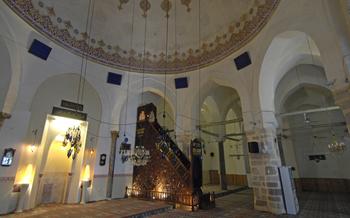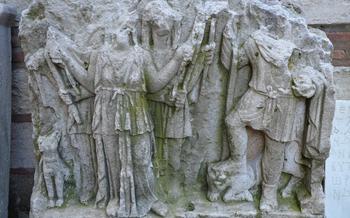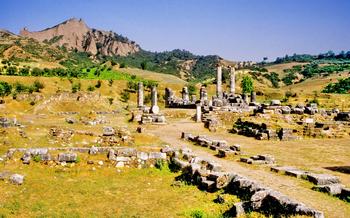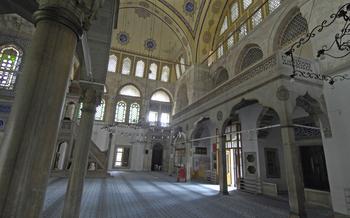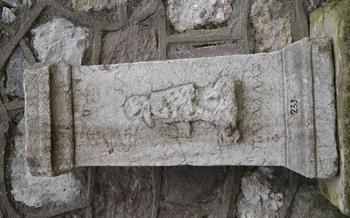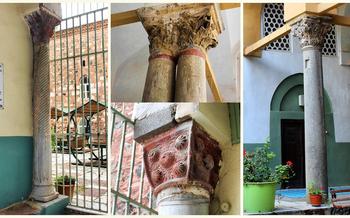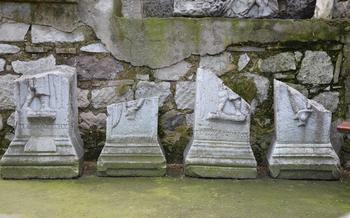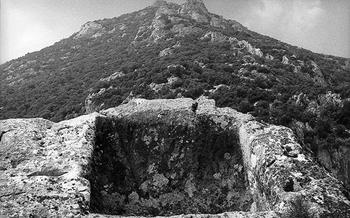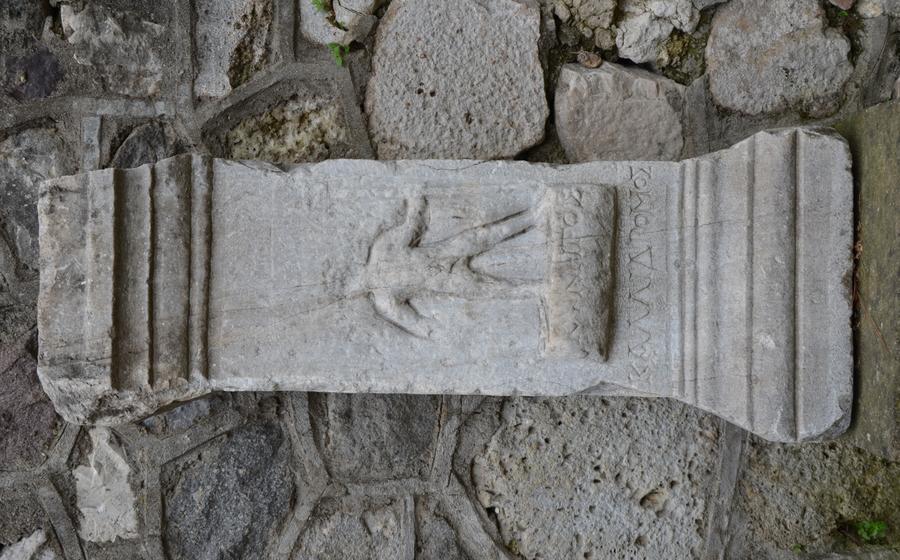
Gelenbe Viaduct
- Gelenbe Viaduct: A Masterpiece of Engineering
- Location and Accessibility
- Architectural Marvel
- Scenic Views and Nature's Embrace
- Train Journey Experience
- Historical Significance
- Maintenance and Preservation
- Visitor Information and Facilities
- Local Cuisine and Delicacies
- Accommodation Options
- Things to Do Nearby
- Events and Festivals
- Photography Tips
- Safety Precautions
- Insider Tip: Hidden Gem
Gelenbe Viaduct: A Masterpiece of Engineering
The Gelenbe Viaduct, an iconic landmark in Manisa, Turkey, stands as a testament to human ingenuity and engineering prowess. Completed in 2010, this colossal structure has transformed the region's transportation landscape and become a symbol of modern architectural marvels.
The viaduct's history dates back to the early 2000s when engineers embarked on an ambitious project to construct a high-speed rail line connecting Istanbul to Izmir. Spanning a length of 4,588 meters, the Gelenbe Viaduct was designed to traverse the rugged terrain of the Manisa countryside, ensuring a smooth and efficient rail journey.
The viaduct's unique design features 66 piers rising majestically from the earth, supporting a continuous concrete deck that seamlessly blends form and function. Its innovative construction employed state-of-the-art techniques, including segmental prefabrication, which allowed for the efficient assembly of pre-cast concrete segments on-site.
As a vital transportation hub, the Gelenbe Viaduct plays a crucial role in connecting Manisa to the rest of Turkey, facilitating the movement of goods and people. The high-speed rail line traversing the viaduct has significantly reduced travel time between major cities, boosting tourism and economic development in the region.
Beyond its practical significance, the viaduct has become a captivating tourist attraction, drawing visitors from around the world. Its stunning views, set against the backdrop of the picturesque Manisa countryside, create a breathtaking panorama that leaves visitors in awe. The viaduct's harmonious integration with nature showcases the delicate balance between human engineering and the natural world.
Location and Accessibility
The Gelenbe Viaduct is strategically located in the Salihli district of Manisa province, Turkey. It lies on the İzmir-Afyonkarahisar railway line, connecting two major cities in Turkey. The viaduct is easily accessible by various transportation options.
For those traveling by car, the viaduct is situated near the D585 highway, which connects İzmir to Ankara. Visitors can simply follow the highway signs to reach the viaduct.
Those opting for public transportation can take a train from either İzmir or Afyonkarahisar. The train journey offers a picturesque view of the countryside, making it a delightful experience in itself.
The viaduct is approximately 140 kilometers from İzmir and 260 kilometers from Ankara. For easy navigation, the GPS coordinates of the Gelenbe Viaduct are 38°28'30"N 28°06'19"E.
Architectural Marvel
The Gelenbe Viaduct stands as a testament to the ingenuity and prowess of human engineering. Its innovative design incorporates a series of continuous steel girders supported by elegant concrete piers, creating a visually stunning and structurally sound masterpiece. The viaduct's construction employed cutting-edge technology for its time, including the use of prefabricated steel components and advanced techniques for assembling and welding the massive girders. This innovative approach allowed for the efficient and precise construction of the viaduct, ensuring its stability and longevity.
The architectural significance of the Gelenbe Viaduct has been recognized both nationally and internationally. It has received numerous awards and accolades for its groundbreaking design and engineering achievements. Comparisons with other notable viaducts around the world often place the Gelenbe Viaduct at the forefront, highlighting its unique features and superior craftsmanship. This architectural marvel continues to inspire engineers and architects, serving as a benchmark for excellence in bridge design and construction.
Scenic Views and Nature's Embrace
The Gelenbe Viaduct is not just an engineering marvel but also a gateway to stunning natural beauty. As you cross the viaduct, you'll be treated to panoramic vistas that stretch for miles in every direction. The surrounding mountains, valleys, and lush greenery create a breathtaking backdrop for this architectural masterpiece.
The viaduct's unique vantage point offers a bird's-eye view of the region's diverse landscape. You'll see rolling hills covered in olive groves, vineyards, and fields of wildflowers. The meandering Gediz River winds its way through the valley below, reflecting the sunlight like a glittering ribbon.
For nature enthusiasts, the area around the viaduct is a paradise. The nearby Spil Mountain National Park is home to a variety of flora and fauna, including rare birds, butterflies, and wildflowers. You can embark on hiking trails that lead through dense forests, past cascading waterfalls, and up to panoramic viewpoints.
The viaduct's location also makes it a great spot for photography. The changing seasons bring different colors and textures to the landscape, creating endless opportunities for capturing breathtaking shots. Whether you're a professional photographer or simply enjoy taking snapshots, the Gelenbe Viaduct offers a stunning backdrop for your creative endeavors.
Train Journey Experience
Crossing the Gelenbe Viaduct on a train is an unforgettable experience that offers a unique perspective of this engineering marvel. As the train glides along the tracks, passengers are treated to stunning views of the surrounding mountains, valleys, and greenery. The viaduct's massive pillars and intricate structure are showcased from a vantage point that allows for a full appreciation of its grandeur.
The sensation of crossing such a majestic structure is thrilling, as the train sways and rocks gently. It's a moment to marvel at the engineering prowess that made this viaduct a reality. Passengers can observe the viaduct's construction up close, admiring the precision and craftsmanship that went into its creation.
To capture the best views during the train journey, it's recommended to sit on the side of the train facing the viaduct. This will provide unobstructed views of the structure and the surrounding landscape. It's also a good idea to keep a camera ready to capture the stunning vistas that unfold as the train crosses the viaduct.
Historical Significance
The Gelenbe Viaduct holds immense historical significance as a testament to Turkey's engineering prowess and its role in shaping the nation's transportation infrastructure. Its construction during the early 19th century marked a pivotal moment in connecting the regions of the country, fostering economic growth and facilitating cultural exchange. The viaduct stands as a symbol of engineering ingenuity, demonstrating the ability to overcome geographical challenges and create pathways for progress.
Throughout history, the viaduct has witnessed the passage of countless trains, carrying people, goods, and stories. It has played a crucial role in the development of the surrounding region, enabling trade, tourism, and cultural interactions. The viaduct's enduring presence has left an indelible mark on the region's history, becoming an integral part of the local narrative.
Moreover, the Gelenbe Viaduct is deeply intertwined with the cultural heritage of the region. Stories and legends have been passed down through generations, attributing mythical powers to the structure and its builders. These tales showcase the deep reverence and admiration the local communities hold for this engineering marvel, solidifying its place in the region's folklore.
Exploring the viaduct offers a unique opportunity to delve into Turkey's rich history, appreciate the nation's engineering achievements, and gain insights into the lives of those who have traversed its path.
Maintenance and Preservation
The Gelenbe Viaduct, as an exceptional engineering feat, requires meticulous maintenance and preservation efforts to ensure its enduring strength and beauty. Regular inspections and assessments are conducted to identify any structural issues or deterioration. Teams of skilled engineers and technicians work diligently to address maintenance needs promptly, using specialized techniques and materials to restore the viaduct's original integrity.
Preserving such a massive structure poses numerous challenges. The viaduct's exposure to harsh weather conditions, including strong winds, heavy rainfall, and temperature fluctuations, can lead to wear and tear over time. Additionally, factors such as seismic activity and vibrations from passing trains must be carefully considered in the maintenance process.
The significance of safeguarding this engineering masterpiece cannot be overstated. By protecting the Gelenbe Viaduct, we not only preserve a vital part of Turkey's transportation infrastructure but also ensure that future generations can continue to marvel at this architectural marvel. Local communities and authorities play a crucial role in this endeavor, working together to promote responsible tourism practices and raise awareness about the viaduct's historical and cultural value.
Visitor Information and Facilities
The Gelenbe Viaduct welcomes a steady stream of visitors who come to marvel at its engineering prowess and immerse themselves in its scenic surroundings. To enhance the visitor experience, several facilities and services are available at or near the site.
Visitor Centers and Information Kiosks:
- Visitor centers or information kiosks provide a wealth of information about the viaduct's history, construction, and significance.
- Knowledgeable staff is on hand to answer questions, offer guidance, and provide maps or brochures to help visitors plan their exploration.
Guided Tours and Self-Guided Exploration:
- Guided tours are available for those seeking a deeper understanding of the viaduct's engineering marvels and historical context.
- Visitors can also opt for self-guided exploration, allowing them to set their own pace and take in the sights at their leisure.
Amenities for Comfort and Convenience:
- Restrooms are conveniently located near the viaduct, ensuring visitors' comfort and convenience.
- Ample parking is available, making it easy for visitors to arrive by car or tour bus.
- Dining options in the vicinity offer a range of culinary delights, from local delicacies to international cuisine.
Accessibility for All:
- The viaduct and its surrounding areas are designed to be accessible to visitors of all abilities.
- Wheelchair ramps, elevators, and designated parking spaces ensure that everyone can enjoy this architectural masterpiece.
Local Cuisine and Delicacies
Manisa province, where the Gelenbe Viaduct is located, is known for its rich culinary traditions and delectable local cuisine. Visitors to the area have the opportunity to savor a variety of dishes that reflect the region's unique flavors and ingredients.
One of the must-try dishes is "Manisa Kebabı," a succulent and flavorful grilled meat delicacy. The kebab is typically made with lamb or beef, seasoned with a blend of spices and herbs, and cooked over an open fire. It is often served with grilled vegetables and a tangy sauce, making it a hearty and satisfying meal.
Another local specialty is "Manisa Köfte," a type of meatball that is made with ground beef, bread crumbs, and spices. These meatballs are usually pan-fried or grilled and served with a variety of dipping sauces, such as yogurt sauce or tomato sauce.
For those with a sweet tooth, "Manisa Mesir Macunu" is a must-try. This unique confection is made with a blend of 41 different spices, nuts, and herbs, and is believed to have medicinal properties. It is often served in small pieces and is a popular souvenir among visitors to the region.
To experience the local cuisine at its best, visitors can head to one of the many traditional restaurants or eateries in Manisa. These establishments often offer a wide range of local dishes, as well as a warm and welcoming atmosphere. For a truly authentic experience, it is recommended to try some of the smaller, family-run restaurants that are frequented by locals.
When dining in Manisa, be sure to sample some of the local wines, which are produced in the surrounding vineyards. The region is known for its high-quality grapes and produces a variety of red, white, and rosé wines that pair well with the local cuisine.
Accommodation Options
The Gelenbe Viaduct is surrounded by a range of accommodation options to suit different preferences and budgets. From cozy guesthouses to modern hotels, visitors can find a place to stay that meets their needs.
For those seeking a comfortable and convenient stay, the nearby town of Manisa offers a selection of well-equipped hotels. These hotels provide amenities such as air conditioning, private bathrooms, and Wi-Fi, ensuring a pleasant and hassle-free stay.
Budget-conscious travelers can opt for guesthouses or hostels, which offer basic yet comfortable accommodations at a more affordable price. These guesthouses often have a friendly and welcoming atmosphere, providing an opportunity to interact with fellow travelers and locals.
For a unique and immersive experience, consider staying in a traditional Turkish house or a restored Ottoman mansion. These accommodations offer a glimpse into the region's rich history and culture, allowing visitors to experience the local way of life firsthand.
It is advisable to book accommodation in advance, especially during the peak tourist season, to avoid any last-minute surprises.
Things to Do Nearby
While exploring the Gelenbe Viaduct, don't miss the opportunity to discover other hidden gems and attractions in the surrounding area. Immerse yourself in the region's rich history by visiting the ancient city of Sardis, once the capital of the Lydian Empire. Explore its impressive ruins, including the Temple of Artemis, the Acropolis, and the Sardis Synagogue, the oldest synagogue in the world.
Take a break from history and embrace nature's wonders at the nearby Manisa National Park. Hike through lush forests, admire stunning waterfalls, and encounter diverse wildlife. The park offers picturesque landscapes for nature enthusiasts and adventure seekers alike.
For a unique cultural experience, visit the Manisa Museum, which houses a collection of artifacts showcasing the region's rich cultural heritage. Learn about the local traditions, customs, and the significant role Manisa has played throughout history.
To satisfy your taste buds, embark on a culinary journey and savor the region's delectable cuisine. Indulge in traditional Turkish dishes such as Manisa kebabı, a succulent grilled meat dish, or keşkek, a hearty wheat and meat stew. Don't forget to sample the famous Manisa mesir macunu, a special paste made from 41 different spices and herbs, believed to have healing properties.
Create a comprehensive itinerary that allows you to explore these diverse attractions while immersing yourself in the local culture and savoring the region's culinary delights. Whether you're a history buff, nature lover, or foodie, you'll find something to captivate your senses in the vicinity of the Gelenbe Viaduct.
Events and Festivals
The region surrounding the Gelenbe Viaduct is steeped in history and culture, with various events and festivals that showcase the local traditions and heritage. Here are some notable events that you might want to consider incorporating into your trip:
-
Manisa Mesir Festival: Held annually in May, this festival celebrates the production of "mesir," a traditional Turkish paste made from a blend of spices and herbs. The festival features parades, music, dance performances, and the distribution of free "mesir" to attendees.
-
Salihli Grape and Wine Festival: Held in September, this festival celebrates the region's grape harvest and winemaking traditions. Visitors can sample local wines, enjoy traditional music and dance performances, and participate in grape-stomping competitions.
-
Turgutlu Olive Oil Festival: Held in October, this festival celebrates the region's olive oil production. Visitors can taste different varieties of olive oil, learn about the olive oil-making process, and participate in olive-picking activities.
-
Gelenbe Viaduct Festival: Held in July, this festival specifically celebrates the Gelenbe Viaduct and its significance to the region. The festival features live music, cultural performances, art exhibitions, and guided tours of the viaduct.
Attending one of these events or festivals during your visit to the Gelenbe Viaduct is a great way to immerse yourself in the local culture and traditions, and to experience the vibrant atmosphere of the region.
Photography Tips
Golden Hour Magic: The golden hours, just after sunrise and before sunset, offer the most flattering light for photography. Capture the viaduct bathed in warm hues for stunning shots.
Multiple Perspectives: Experiment with different angles to showcase the viaduct's grandeur. Shoot from below to emphasize its towering height, from the side to capture its graceful curves, and from above for a bird's-eye perspective.
Play with Lenses: Use a wide-angle lens to fit the entire viaduct into your frame, a telephoto lens to zoom in on its intricate details, and a macro lens to capture the textures and patterns up close.
Filters and Editing: Enhance your photos with filters that bring out the viaduct's colors and contrast. Experiment with editing software to adjust exposure, shadows, and highlights for a polished look.
Composition is Key: Apply the rule of thirds to create balanced and visually appealing compositions. Position the viaduct off-center and include elements like mountains or trees to add depth and context.
Safety Precautions
The Gelenbe Viaduct is a safe and well-maintained structure, but visitors should still take necessary precautions to ensure their safety. Here are some guidelines to follow:
- Stay on Designated Paths: Remain on designated paths and walkways while exploring the viaduct. Do not venture onto restricted areas or climb on the structure itself.
- Mind the Height: Be aware of the height of the viaduct and avoid leaning over the edges. Keep children close and ensure they are supervised at all times.
- Wear Appropriate Footwear: Wear comfortable and sturdy shoes, as the ground around the viaduct may be uneven or slippery.
- Follow Weather Conditions: Check the weather forecast before your visit, as strong winds or rain can make the viaduct slippery and dangerous.
- Be Aware of Trains: Trains regularly pass through the viaduct, so be mindful of their schedules and stay clear of the tracks.
- Emergency Preparedness: Keep emergency contact information handy and be aware of the nearest medical facilities in case of any accidents or medical emergencies.
Insider Tip: Hidden Gem
While the Gelenbe Viaduct itself is a breathtaking sight, there's a hidden gem nearby that offers an equally stunning perspective. Just a short hike away from the viaduct, you'll find a secluded spot that unveils a panoramic vista like no other.
To reach this hidden gem, follow the trail that leads away from the viaduct towards the surrounding hills. After a leisurely 15-minute walk, you'll be rewarded with a breathtaking view of the viaduct nestled amidst a verdant valley. The viaduct's imposing structure takes on a new dimension from this vantage point, creating a picture-perfect moment.
This hidden spot is ideal for capturing unique photographs of the viaduct, especially during sunrise or sunset when the warm hues of the sky illuminate the landscape. It's also a great place to simply relax, soak in the tranquility of nature, and appreciate the engineering marvel from a different perspective.
Remember to bring your camera, as this spot offers endless opportunities to capture stunning images of the viaduct and the surrounding natural beauty. Embrace the serenity of this hidden gem and create lasting memories of your visit to the Gelenbe Viaduct.
